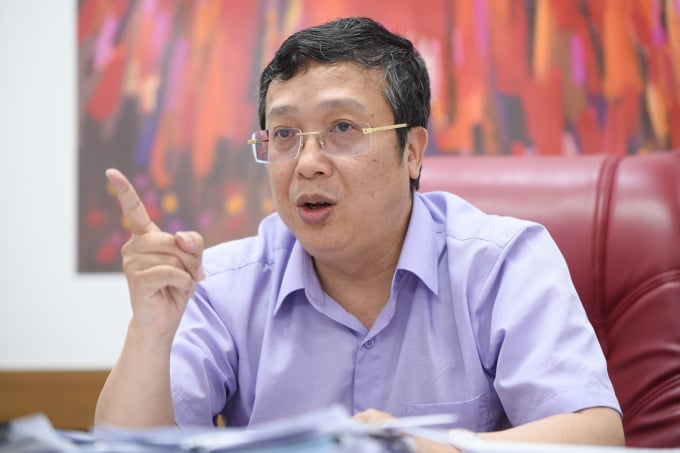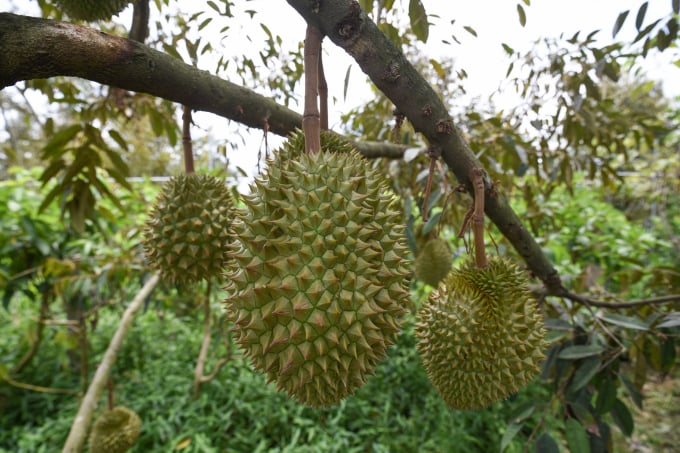November 28, 2025 | 04:19 GMT +7
November 28, 2025 | 04:19 GMT +7
Hotline: 0913.378.918
November 28, 2025 | 04:19 GMT +7
Hotline: 0913.378.918

Director of the Department of Plant Protection Hoang Trung said that Vietnam is waiting for China to complete the procedures and propose a date and time for the two sides to sign the Protocol for durian. Photo: Tung Dinh.
Director Hoang Trung stated that Vietnam has urged the Department of Animal and Plant Quarantine, under the General Administration of Customs of China to complete all necessary steps to sign the Protocol allowing the export of Vietnamese durian to the country.
According to the head of the Department of Plant Protection, the Protocol may be signed virtually or delivered to Vietnam with the Chinese side's signature for finalization before being returned to China. After the signing, durian is exported to China officially.
"We've spent a considerable deal of time and effort preparing for durian in particular. Chinese partner selected and inspected all packaging facilities and representative planting regions in Vietnam", Mr. Hoang Trung added.
According to the director, the Department of Plant Protection has systematized and forwarded to China the whole number of planting area codes, packing facilities, and businesses registering for exports. The agency also dispatched delegates to production areas for communication and training on technical issues to prepare for exports.
"With such meticulous preparation and the farmers' and businesses' understanding of China's technical requirements, I expect that, following the approval Protocol, the export process of durian to China will be run smoothly and fruitful", Director of the Department of Plant Protection Hoang Trung told Vietnam Agriculture News.

The Department of Plant Protection will support technical problems in the fastest, most convenient, and most time-saving manner so that businesses can soon deliver the goods to China. Photo: Tung Dinh.
Mr. Hoang Trung stated that all conditions for the export of durian have been completed, including enterprise names, planting area codes, and packing facilities, but it is crucial that durian producers are aware of which technical standards must be met.
In addition, companies, farmers, and management agencies must reply to the Chinese side's requests for production records, documents, and food safety supervision programs before harvest.
We must guarantee that goods from registered planting area codes adhere completely to the regulation and that the harvested fruits fulfill all of the criteria, which were disseminated to farmers and businesses.
Mr. Hoang Trung summarized three fundamental requirements, which are to have appropriate management measures to eliminate the pest objects of the Chinese side's interest; meet the requirements of food safety and hygiene, with no pesticide residues exceeding the permitted level; and strictly comply with the packaging regulations and labeling requirements.
Currently, the Plant Protection Department has carefully communicated these regulations to farmers and durian-producing enterprises. If any problems or difficulties arise during implementation, specialist authorities such as the Plant Protection Department are available to assist.
In addition, the Department directs the entire plant quarantine system where the products arrive in order to verify the items' origin, packing, and compliance with technical specifications. This procedure will be carried out in the fastest, most convenient, and most time-efficient manner so that enterprises may swiftly deliver goods to China.
Mr. Hoang Trung stated that in order to facilitate the export of Vietnamese key crops, the department has directed and instructed localities to establish criteria, standards, and standardized documents in order to decentralize the duties of establishing planting area codes and packaging facilities to local levels.
Therefore, localities would be proactive in inspecting and evaluating planting sites and packaging facilities based on preset criteria and providing updated information to the Department of Plant Protection before the latter completes the final phases and submits for national recognition.
The Department of Plant Protection always recommends businesses and individuals who have been granted a planting area code produce sustainably rather than focusing on just one or two shipments. However, the ultimate goal is that the source of raw materials must be maintained for many years, meeting both quality and technical requirements for quarantine and food safety.
According to Mr. Hoang Trung, it is vital to attract the appropriate attention and investment of localities in order to preserve the recognized codes and facilities, while also taking scale-up into account.

Maintaining and expanding the planting area codes as well as the standard packing facilities requires proper attention and investment from localities. Photo: Tung Dinh.
In addition, businesses must maintain tight connections with farmers, as a single code may be issued to several agricultural households. Enterprises must act as coordinators, encouraging individuals to join to produce in a single planting area code.
Mr. Hoang Trung noted that professional agencies must pay attention to farmers and businesses in order to establish favorable conditions for production and exports.
"China has partnered with the Plant Protection Department to undertake online inspections in regions with area codes for agricultural exports to China during the past time. At the request of China's General Administration of Customs, this work will continue for at least three months ", Director Hoang Trung provided an example.
The official for the Department of Plant Protection stated that the department has instructed the whole system to rigorously examine planting area codes, assuring the exactness of persons, code, and product, and preventing the counterfeit of codes. In addition, it strengthens technical forces at border gates in order to inspect large quantities of goods and force their return if they do not fulfill technical criteria.
With such organizational techniques, a synchronous posture from the central to the local, and notably the attention of local authorities and specialized agencies, we will be able to enhance the quality and increase the scale of the planting area codes and packaging facilities serving exports.
Translated by Linh Linh

(VAN) China’s cooking oil is suddenly flooding into India. It all comes down to a soybean surplus that Beijing doesn’t quite know what to do with.

(VAN) An Giang promotes supply-demand connections, standardizes quality and builds value chains, creating a foundation for sustainable bird’s nest development and aiming to expand exports.
/2025/11/24/5339-4-nongnghiep-075331.jpg)
(VAN) Recently, the conference on 'Sustainable Fisheries Linkage Chain - Tilapia for Export' took place in Tien Hai commune, Hung Yen province.
/2025/11/21/4309-2-153400_128.jpg)
(VAN) Green and low-emission rice is paving the way for Vietnamese rice to enter high-end markets, marking the beginning of a transformation journey toward greening and elevating the national rice brand.

(VAN) ‘Right to Win’ outlines a national action plan that shapes a new vision for Viet Nam’s agriculture in an era of renewal and global integration.

(VAN) Lam Dong’s farmed sturgeon output this year is expected to reach 2,300 tons, worth VND 450 billion, affirming the brand’s position on the market.

(VAN) A surge in Ukrainian egg exports, largely driven by soaring sales to the UK over the last few years, has notably pushed up egg prices on the domestic market.